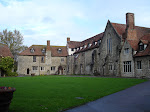
Philippa Roet (c 1346 - c 1387) - also known as Philippa Pan or Philippa Chaucer - was the sister of Katherine Swynford and the wife of Geoffrey Chaucer.
Philippa was the daughter of Sir Gilles de Roet, who was a knight of Hainault and accompanied Queen Philippa to England. There is no history of her mother, but it is thought that Philippa had two sisters and a brother: Katherine, Elizabeth, and Walter. Her father went to serve the queen’s sister, Marguerite, who was the empress of Germany and the four children were left in the care of Queen Philippa.
It was her father’s relationship with royalty that gave Philippa and her family high status and a reputation among the upper class, who took Philippa in as a ‘domicella,’ or lady-in-waiting. She began in the households of Elizabeth of Ulster and Queen Philippa, and ended with Costanza of Castile. These associations proved to be valuable, as Philippa began to receive annuities from Edward III, Richard II, and John of Gaunt, Costanza’s husband.
Philippa is believed to have picked up the nickname “Philippa Pan” while working at Elizabeth of Ulster’s household. There are records from 1357-1359 from the house of Elizabeth of Ulster which mention “a lady designated as Philippa Pan”.[7] “Pan” may have been abbreviated for the word “Panetaria,” meaning mistress of the pantry, which is most likely where Philippa worked in the Ulster household. The name might also come from her father, who sometimes went by ‘Paon’ or Payne.
Geoffrey Chaucer was commissioned to work as a page in Elizabeth’s household in 1357, where Philippa was already working as a domicella. This is where they are believed to have met After Elizabeth’s death, both were sent to work for the queen, caring for her infant daughter, Philippa of Eltham. Philippa was around 10 years old at the time and Chaucer was said to be around 12. Their marriage might have been arranged by Queen Philippa herself in September 1366. It was apparently tradition for domicellas and esquires who worked in the same household to marry.
Once married, although granddaughter Philippa of Eltham was grown, it was decided they would continue working for her and the king.[14] As a result of this marriage, Queen Philippa and King Edward III granted lifetime of annuity to the couple in 1366. This payment allowed the Chaucers to set up a household within the royal one. Chaucer was then taken into the King’s household in 1367. These salaries gave the Chaucers great financial security and a good lifestyle. After the death of the queen, Philippa went to the service of Costanza of Castile and John of Gaunt, the Duke of Lancaster. Following Costanza’s death in 1394, John wed his mistress, Katherine, who was also Philippa’s sister. His connection with two prestigious families significantly increased the Chaucers’ status in society. Due to the varying nature of their jobs, Chaucer and Philippa were often forced to spend much of their time apart. Great consideration has been given to the possibility that the difficulties in the Chaucer’s marriage were mirrored in Chaucer’s Franklin’s Tale, which shows how a strategic marriage might be experienced. This possibly reveals how his marriage to Philippa helped Chaucer improve his social status since.
Children
It is probable that Chaucer and Philippa had “two sons and two daughters,” whose birthdates are unknown. It is speculated that “one or two” of these children were actually fathered by John of Gaunt. This is likely, as Philippa and Chaucer both spent a great deal of time in the Gaunt household.
Elizabeth is thought to be the oldest of their children, but her parentage is still open to debate. Her birth prompted King Edward to give the Chaucers another annuity. She may have been a nun in Barking Abbey; there are records of an “Elizabeth Chausier” and her nickname being “Chaucy” which leads historians to believe that she was their daughter. It is also thought that she was named after Elizabeth of Ulster.
Thomas, the eldest son and most well known, might have been born around 1367 judging from the dates he entered the military; it is suggested that he was the son of John of Gaunt, whom he served under and received favors from. A strong relationship with Philippa is also suggested due to the fact that Thomas chose to bear her coat of arms over Chaucer’s. However, this could be due to the prestigious title of her family; it is recorded that in 1409, Thomas then chose to bear Chaucer’s coat of arms.He died in 1434.
Very little is known of Lewis and Agnes, the second son and youngest daughter. However, it is recorded that Lewis was born in 1381 and sent to the school at Oxford at age 10; Agnes, who is believed to be his second daughter, was a lady-in-waiting at Henry IV's coronation in 1399.
Although there is no true evidence, Philippa is thought to have died in 1387, due to her last recorded pension being on 18 June 1387. This is evidenced by Chaucer’s last recorded overseas journey, which was in the same year. It is also suggested that he may have fallen out of favor with the court following her presumed death.














